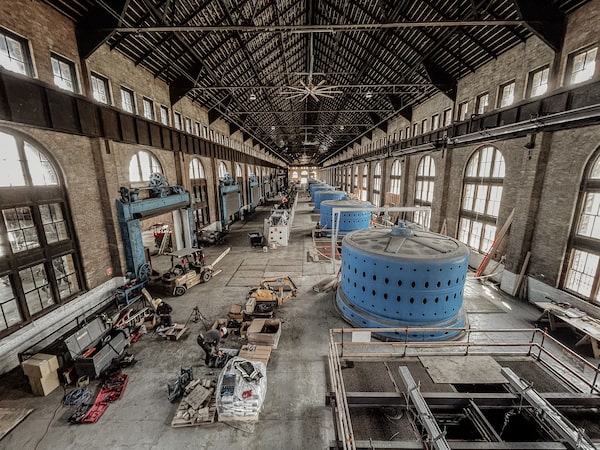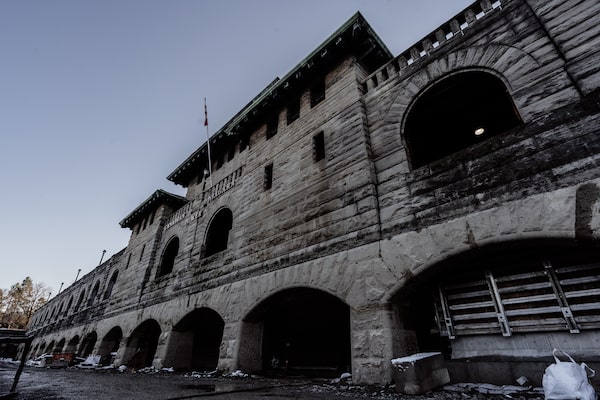
The Niagara Parks Power Station, which was the first alternating current station in Canada when it opened in 1905, has been reimagined and restored as a museum and event space.
For a century, Niagara Parks Power Station produced electricity; then, for a decade, the building lay abandoned, sad and neglected. Now, the monumental stone building by Niagara Falls has been reimagined and restored as a museum and event space to tell the story of how it helped power Ontario.
The station, opened in 1905, was the first alternating current station in Canada and produced power until it was closed in 2006. Niagara Parks, the Ontario government commission that maintains the Canadian shoreline of the Niagara River, acquired the property in 2009.
“It was a $14-million liability on our books,” says David Adames, chief executive officer of the Niagara Parks Commission. Architects and engineers pondered how such a magnificent structure from the industrial age could be repurposed and reintegrated as an attraction in Niagara, Canada’s most popular tourist destination.
“Sometimes it just comes down to having the right people in the right place at the right time to make something like this happen,” Mr. Adames says. First, Niagara Parks put together a business case: Even as a closed-up liability, the building needed upkeep while maintaining its original, historically significant architecture. Commission executives liken it to a cathedral of power.
Since part of the commission’s mission is to preserve and conserve existing assets alongside the Falls, it put rehabilitating the massive station into its overall 10-year strategic plan in 2018. The following year, the commission persuaded the provincial government to put up a $25-million loan to start the restoration.
Turning a monster-sized power station into a commercial building for tourism is a complicated task, says Marcelo Gruosso, senior director of engineering, parking and transportation for Niagara Parks. The building may have been decaying, but its bones were solid limestone and granite, with brass and copper fittings.

Turning a monster-sized power station (top right) into a commercial building for tourism is a complicated task.
It was designed to inspire awe and public confidence in electricity, which, in 1905, was still new technology.
“We’re not used to the scope and scale of these buildings,” Mr. Gruosso says. “Every time you touch something, you have to address another issue, and everything had to be done 11 times.”
Things had to be done 11 times because the power station had 11 generators, each producing 10,000 horsepower when they were operating, together harnessing the force of 140,000 litres of water per second diverted from the Niagara River. The tops of the generators, which look like giant blue metal birthday cakes, are lined up in a 600-foot-long hall.
While the generators no longer operate, one of the jobs now was to shine them up and restore their look, making sure the entire site is safe for visitors.
“We had to make sure everything was safe across the whole facility, and once you find one issue in one generator, you have to check all the others. We threw a lot of resources into the work to get it done quickly,” Mr. Gruosso says.
We’re not used to the scope and scale of these buildings. Every time you touch something, you have to address another issue.
— Marcelo Gruosso, senior director of engineering, parking and transportation for Niagara Parks Commission
“It was especially challenging to undertake the work through COVID-19 protocols,” says Kim Viney, senior director of business development for the commission. “We had to respect all the significant heritage features of the building and at the same time consider what will appeal to our guests’ experience when they visit.
“It’s a balance between business constraints and opportunities and keeping as much of the building intact and authentic as possible, but including amenities needed today.”
The project updated environmental features, for example, replacing the gigantic windows with modern panes that look the same as the originals but are thermally efficient. The building was also made compliant with provincial disability access rules.
It took 400 workers and 75 contractors to rehabilitate the station. Phase One of the work began in 2018 and was completed in time for the facility to open for visitors this summer.
In 2020, the workers built a cofferdam – a watertight enclosure – to hold back the river so they could reinforce the walls. It was daunting enough using modern technology; Mr. Gruosso marvels at the fact that workers did the same thing 115 years ago when the building was constructed using shovels, muscle and the low-tech steam-powered and mechanical equipment of the day.

The tops of the generators are lined up in the station's 600-foot-long hall.
Working on the project during the pandemic further motivated the team to get it done. Niagara Parks had its best year in tourism revenues in 2019 before COVID-19, followed by one of its worst years in 2020. “There was always a case for preserving the building and now there’s a case for enhancing tourism, too,” Mr. Adames says.
“COVID-19 actually strengthened our team,” Mr. Gruosso says. “It was a way to keep our people working when our other attractions were shut down and prepare for when revenues start coming in again. It’s a form of reinvesting.”
The gigantic generator hall, open since September to visitors for interactive tours and an eye-popping immersive sound-and-light show in the evening, is only the tip of what Niagara Parks operators call a giant iceberg of a power plant.
When it operated, the water would whoosh through the generators and the 11 vertical steel penstocks, converting energy into electricity before it moved through a tunnel to the Falls.
Energy was produced by sending the water through 45,000-pound machines called exciters, which spun at 600 revolutions a minute – nearly 20 times faster than a vinyl LP. One of the exciters has been reduced to 16,000 pounds, coated for weather protection, and placed outside the building as an art installation.

The project required erecting a cofferdam – a watertight enclosure – to hold back the river so workers could reinforce the walls.
Renovating the tunnel where the water flowed for visitors is the next phase in construction, already under way and slated to be completed in the summer of 2022. Phase 2 will allow visitors to follow the water’s path by taking a glass elevator down the shaft, following a 2,200-foot walkway (with the water streaming safely beside them) and arriving outside to a new view of the American Falls and the Niagara Gorge.
The project is the first of three buildings that Niagara Parks hopes to restore to early 20th-century grandeur. In November, the commission issued requests for information seeking ideas for two additional nearby stately buildings it has acquired along the river: Toronto Power Generating Station and Ontario Power Company Generating Station.
Proponents of hydro-powered clean electricity need not worry that these buildings no longer produce electricity; the two Sir Adam Beck generating stations down the Niagara River together supply about 9 per cent of Ontario’s electricity.
After COVID-19, there are plans to enhance the new museum’s amenities, with gourmet dining for example, Ms. Viney says. In the meantime, Niagara Parks wants visitors to come experience the immersive light show in the generator hall, when such attractions are permitted. “It’s a show that can only take place in this space,” she says.
“It tells a story that connects the past with the present and the future. It’s the story of electricity and how we should not take it for granted – and it’s really the story of the power of the Falls.”